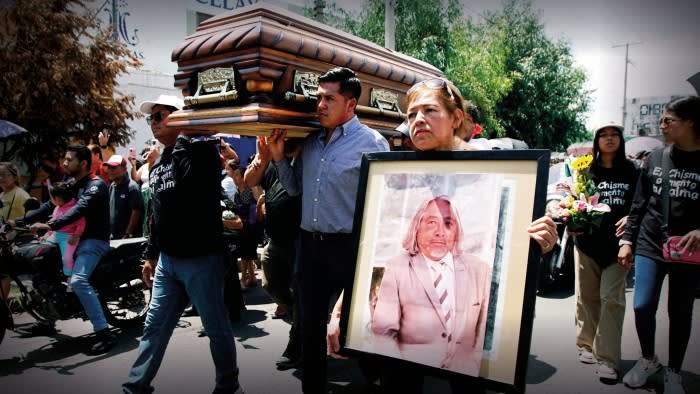Less than two years ago, Mexican crime reporter Alejandro Martínez had an unusual assignment — reporting an attempt on his own life.
The veteran journalist broadcast an hour-long live Facebook video from the central city of Celaya, one of the world’s most dangerous places, breathing heavily as he covered the police’s slow response and tried in vain to work out who wanted to kill him. No one was ever detained.
This month, gunmen drove up to a police car that Martínez was travelling in and shot him dead.
“The violence that we face is not normal,” said Marcos Vizcarra, a reporter for online magazine Revista Espejo from the northern city of Culiacán, a stronghold of the Sinaloa cartel. Any reporter who covers crimes such as forced disappearances and extrajudicial killings “is at risk of becoming a victim”, he added.
As criminal groups expand their power and influence, Mexico has become one of the world’s most dangerous countries for journalism, with more reporters killed in some years than in war zones such as Ukraine or Syria.
Martínez, who called himself “The Son of the Lone Ranger”, became the 47th journalist killed during the nearly six-year presidency of Andrés Manuel López Obrador, one short of the record for a single administration.
The violence stems from a climate where organised crime and local authorities work together in near impunity, and parallels a broader rise in murders since 2008 as drug-trafficking groups contested territory and expanded into migrant trafficking, oil theft and extortion. The leftist president’s verbal attacks on reporters have empowered their aggressors, press freedom campaigners say.
Without support or reliable income and often out in the streets covering stories, self-employed journalists who publish mainly on social media, as Martínez did, are particularly at risk.
“These are journalists in a state of extreme vulnerability because they’re so easily identified,” said Jan-Albert Hootsen, Mexico representative for the Committee to Protect Journalists. “They usually work under a lot of pressure . . . they’re focused almost singularly on reporting, and that makes the job very dangerous.”
Collusion between criminal groups and local authorities means many potential cases linked to killings of reporters or their work are not pursued. Though the extreme violence is not new, the threats to journalists have evolved on López Obrador’s watch, creating a more hostile political and social environment for investigative journalism.
He calls media organisations “factories of lies and manipulation” that are at the service of “vested interests”. His morning news conferences have a weekly section called “who’s who in lies” that names and shames reporters. He has published the phone number of a foreign correspondent, private tax information of a critical reporter and the salaries of editors running an investigative journalism outlet.
In such a tense climate, there have also been assassination attempts on high-profile journalists. Would-be assassins tried to kill prominent news anchor Ciro Gómez Leyva near his Mexico City home in 2022.
The president’s language is replicated at the local level, including by opposition parties. “It provokes a very particular animosity and an environment of permissiveness,” said Leopoldo Maldonado, regional director at press freedom group Article 19. “It enables aggressors to keep acting against the press.”
Freelance reporter Reyna Haydee Ramírez stood up in the president’s morning conference this month and recounted stories of being harassed on the street by his supporters. She then delivered a stern message.
“You polarised society . . . if anything happens to me, I hold you responsible,” she told López Obrador. The president has said his government respected freedom of expression and that there was no impunity in cases of journalist killings. Several people have been detained and sentenced in relation to some of the cases, including the attempt to kill Gómez Leyva.

Some 650 journalists in Mexico are under the protection of a government programme known as the “mechanism”. Created in 2012, it offers security measures from panic buttons to CCTV cameras and armed protection outside their homes.
Rights groups say more needs to be done despite improvements and an increase in funding for the programme. Several journalists, including Martínez, have been killed despite being in the mechanism.
Vizcarra had to move after his frontline coverage of the second “Culiacanazo” battle in 2023, when gunmen took on the armed forces in protest the arrest of a son of former cartel leader Joaquín “El Chapo” Guzmán.
The reporter said drug-trafficking coverage was obviously risky, but so was reporting on powerful political and business interests. He had recently been warned to stay away from Sinaloa’s highlands and avoid reporting on the exploitation of indigenous people in the region.
“[They said] don’t go up there because now you know what will happen,” he said. “It’s a zone that’s been silenced . . . and it’s really sad.”
Even in more high-profile cases where arrests or convictions have been made over the killing of a journalist, the individuals who ordered the hit are rarely found.
“The masterminds are never identified, because that’s where politics and crime converge,” said Article 19’s Maldonado.
María Elena Ferral was murdered in Veracruz in 2020 after publishing a critical column on local political power struggles. Her daughter Fernanda, who now lives under protection, sees little hope of a change under Claudia Sheinbaum, López Obrador’s protégé who becomes president in October.
“The media has certain topics that are off-limits, there is too much impunity,” Ferral said. “I’ve been doing this for five years and I don’t see that we will get justice from the Mexican state.”
Data visualisation by Aditi Bhandari


